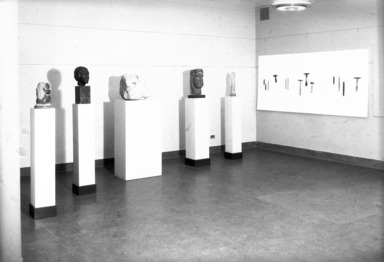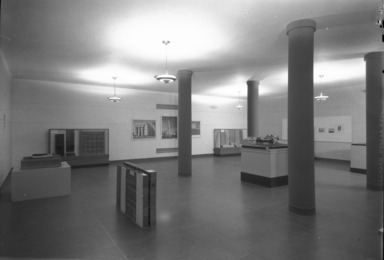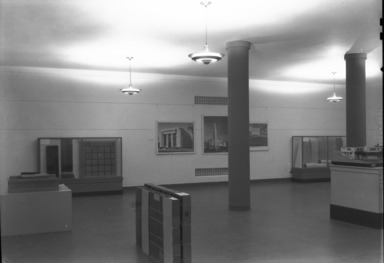

Contemporary Materials and Techniques in the Fine Arts, January 31, 1936 through March 01, 1936 (Image: PHO_E1936i001.jpg Brooklyn Museum photograph, 1936)
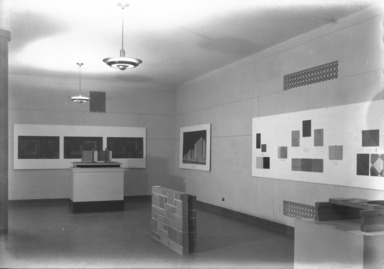
Contemporary Materials and Techniques in the Fine Arts, January 31, 1936 through March 01, 1936 (Image: PHO_E1936i002.jpg Brooklyn Museum photograph, 1936)
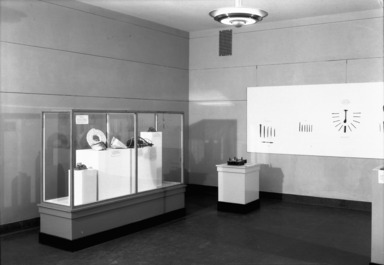
Contemporary Materials and Techniques in the Fine Arts, January 31, 1936 through March 01, 1936 (Image: PHO_E1936i003.jpg Brooklyn Museum photograph, 1936)

Contemporary Materials and Techniques in the Fine Arts, January 31, 1936 through March 01, 1936 (Image: PHO_E1936i004.jpg Brooklyn Museum photograph, 1936)
Contemporary Materials and Techniques in the Fine Arts
-
January 31, 1936
The exhibition of contemporary materials and techniques in the fine arts, installed in the special exhibition galleries on the first floor of the Brooklyn Museum, will be opened on the afternoon of January 31st with a reception and private view for members and guests of the Museums. It will run through March 1st. The exhibition comprises paintings in oil, tempera, gouache and water color, sculpture in stone and bronze, prints by etching, engraving, lithography and wood-block, drawing in several media, architecture, represented by models and photographs, and simples of various novel building materials. The sculptor’s and print maker’s - tools, the painters brushes, pigments, and media, the draftsman’s pencils are also exhibited.
The materials have been selected and prepared by Mr. John I.H. Baur, Supervisor of Education, and by Mr. Sheldon Keck, Restorer. They have been installed with the cooperation of Miss Christine Krehbiel, Stylist, and Mr. Albert N. Henricksen, Superintendent, in charge of the engineering and technical staff of the Museum.
The works of art have been chosen with a view to showing masterpieces by contemporary artists which illustrate the use of various techniques. There are architectural models by Le Corbusier, Howe and Lescaze, Neutra, Mies Vander Rohe and Motohomes, the last being portable houses. There is sculpture in stone, wood and bronze by De Creeft, Maillol, Hernandez, Warnecke, Milles, Laurent, Botzaris, Kolbe, Epstein, etc. There are drawings by Maillol, Lachaise, Gill, Kolbe, Pauli, Canade, Pascin, dc Segonzac, Kandinski, Flannagan and others; prints by Drewes, Gill, Schmidt-Rothulff, Labourer, de Segonzac, Bracque, Sintenis, Peggy Bacon, Rivera, Roualt, etc. There are paintings by Dali, Kuhn, Bellows, Kenneth Miller, Monet, Bodley, de Segonzac, Sargent, Edy-Legrand, Isabel Bishop, March, Laning, Signac, Marin, Hopper, Schreiber, Dufy, O’Hara, Edy-Legrand, and others.
The effect is that of a very carefully selected fine arts exhibition, classified into sections according to the medium employed. Save for the striking and rather decorative displays of tools, pigments and the like, the analysis of techniques, which is one of the primary intentions of the installation, is not obtrusive, though variations in technical procedure are pointed out by careful labeling. Still the visitor who enjoys looking at works of art but who does not care particularly how they are made can enjoy the exhibition merely for the artistic value of the various paintings, drawings, pieces of sculpture, prints and models, and for the excellent installation which makes it easy to examine them without bothering about materials and techniques. For others, who care supremely about how a thing is done, the exhibition itself and the carefully written and lavishly illustrated handbook should prove unusually valuable.
In painting one is instructed in the mysteries of heavy and thin, smooth and rough impasto, direct painting and indirect painting by means of underpainting, glazing and scumbling, various aspects of impressionism including broken color and the extremely mannered breaking achieved by pointillism, and in contrast variations on so-called classical techniques. In store sculpture one is able to observe the influence on form and surface texture of various rocks, ranging from alabaster to granite. In bronze sculpture different surface finishes and the effects due to the qualities of the original model are made clear. Prints, plates and blocks illustrate the different characteristics of the several primary techniques of print making, and several subtleties of the craft, for instance the difference between wiping plate clean and dragging the ink.
Instructive and interesting the exhibition undoubtedly is, but no one whould be dissuaded from visiting it for fear it should prove unduly educational. Didactic it certainly is, but dull it certainly is not, and unless one roads the labels one need not be excessively instructed. The artists speak for themselves by some of their best works, and no pedagogical intention can prevent them from doing so.
10 11Brooklyn Museum Archives. Records of the Department of Public Information. Press releases, 1931 - 1936. 01-03_1936, 010-1.
View Original
